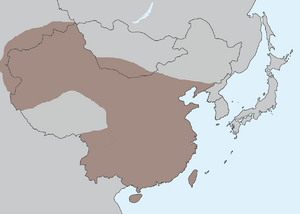The Qurbanid Dynasty
Qurbanid Empire بۇيىك قۇربان دۆلىتى 大瑪 | |
|---|---|
| 1303–1729 | |
the Ma Dynasty on the eve of the death Sultan-Emperor Abduraşid (excluding vassals) | |
| Government | Absolute Monarchy |
| Historical era | Early Modern |
• Dynasty Founded | 1303 |
• Tarim Basin Conquered | 1328 |
• Crossing of Gansu Corridor | 1401 |
• Siege of Xi'an | 1408 |
• Siege of Nanjing | 1446 |
• Reign of Sultan-Emperor Malik-Şah | 1552 |
• Death of Sultan-Emperor Abduraşid | 1640 |
• First Manchu-Qurbanid War | 1660 |
• Siege of Guangzhou | 1729 |
| |
The Qurbanid Dynasty; the Ma Dynasty (Chinese: 瑪朝; pinyin: Mǎ Cháo); the Great Qurbanid State or Great Ma (Uyghur: ئۇلۇغ قۇربان دۆلەت; Chinese: 大瑪), was a Turco-Persianate and Sunni Muslim Chinese Imperial dynasty of primarily Karluk origin. Named after the founder of the dynasty Sultan Kurban Khan in 1303, the empire, as established by his grandson Ürkeş after the consolidation of the former lands of the Chagatai Khanate in 1328, would come to rule the entirety of modern day China by 1565, which would last until 1724 after the the Qing Conquest.
The dynasty was founded by Kurban who originally a lower Turkic beg serving under the ailing Chagatai Khanate who seized power in the religious and succession crisis that engulfed the Khanate, emerging as the premier ruler of the Tarim Basin and given the title Sultan. In subsequent years, the tenure of the reportedly eccentric Kurban saw revival of old silk road routes and the rationalisation of state administration in the Qurbanid sultanate. After his death, his successor, Sultan Satuq began preparations for an expansion to fulfil his own grand visions of conquest. Unlike many Turco-Persian rulers who aimed to push west, Satuq, due reportedly to a vision, was compelled to advance east and conquer China, where the incumbent Yuan dynasty was facing the Red Turban rebellions, sensing weakness. Satuq himself would never invade China, dying in 1399 after years of preparation to illness. Succeeded by his son Ürkeş Sa'id, a capable commander and organiser, the first Qurbanid invasion of Northern China would begin in 1401, culminating in a number of campaigns which saw successive parts of China fall to the Kurbanids, such as the fall of Xi'an, Beijing, and Nanjing in 1408, 1420, and 1446 respectively. The final Qurbanid conquests would end in 1565 when the province of Yunnan was finally conquered. Upon the establishing of a strong posistion in China after 1402 the Kurbanids declared their own dynasty and claimed overlordship of all of China, adopting the name Ma or 瑪.
Though the Kurbanids initially were considered both by themselves and the native Chinese as foreign rulers, the Kurbanids would come to sustain a religiously and ethnically diverse and relatively peaceful empire that simultaneously maintained its Islamic and Turco-Persianate nature to the point that historian Ana Markova would describe the Kurbanids as "... the least assimilated non-ethnic Han dynasty in Chinese history - indeed its most foreign." While the ruling caste retained their Turco-Persianate culture, traditions, and language, with various outbursts of cultural and religious imposition such as in the assertion of Sunni Orthodoxy and the promotion of Turco-Persianate culture amongst Chinese elites by Sultan Kutalmiş (1508-1522), the Kurbanids would, both through happenstance and concerted efforts, manage to incorporate the local Chinese and non-Muslim population into its imperial structure. It did this through a combination of strategic toleration and military force. The cultures and peoples the Kurbanid Empire ruled were not actively suppressed and granted degrees of autonomy in exchange for recognition of or service to the Kurbanids, as well as the incorporation of local elites and officials into the state bureaucracy, which would also come to take on more Chinese characteristics - all of which was backed by the ever present threat of military reprisal.
In such a diverse environment, cross-cultural exchange was prevalent and Kurbanid rule is generally regarded as a high point for cultural production owing to the unique cultural synthesis and strong patronage networks under Kurbanid and Chinese elites, which saw many great works of art, literature, poetry, and fashion being created during Kurbanid rule. The early decades of Kurbanid rule saw stricter ethnic and confessional hierarchies and division being set, with Turks and Persians erecting social and legal boundaries and excluding or even oppressing the local Chinese population. However, but later periods would see a relaxing of ethnic and religious boundaries, though Muslims maintained elevated positions in Kurbanid society. As these boundaries relaxed, more direct cross-cultural exchanged would simultaneously take place, with Chinese cultural influences making stronger penetrations into the ruling Turco-Persian class than it previously had, even before the Kurbanid invasion. Chinese cultural trends in fashion, art, music, and poetry would become popular and synthesise with existing Turco-Persian and Islamic trends, with the reverse case itself being a major phenomenon as well.
Kurbanid rule in China also saw vigourous engagement in trade and cultural ties with essentially all its neighbours, with a marked increase of contact between the the Islamic world and the Sinosphere, not to be outdone by the Empire's efforts at contact with Asia-Pacific states. The state pursued a relatively free and open trade policy that saw ports and trade routes open to merchants from all over the world free to do business with few restrictions, leading to the nickname of the vast networks of Chinese mercantile trade: 'the Thousand Lilies'. The Kurbanids additionally sought to make extensive contacts and trade with the rulers and notables of other states from as far as the Swahili coast to Japan. A number of expeditions and travels compendiums have been preserved from the era, making note of the sights and wonders of the world.
